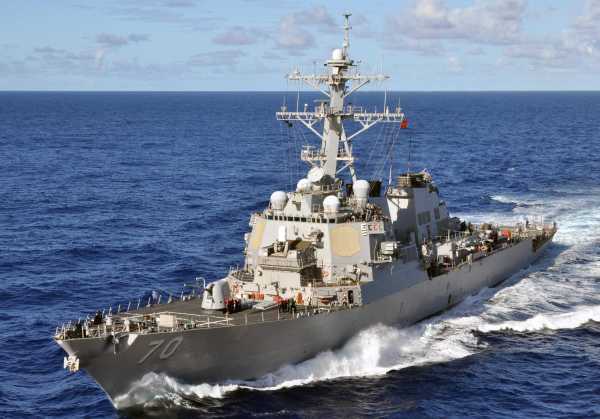Things just got a lot tenser between the United States and Russia. Yesterday, a Russian fighter jet deliberately and repeatedly “buzzed” the USS Donald Cook, a destroyer that was transiting the Black Sea towards the Romanian port of Constanta. This was no accident; the Sukhoi-24, an all-weather strike fighter, made a dozen passes over the Donald Cook in international waters while ignoring all efforts by the ship to communicate with it.
The Donald Cook is the second U.S. warship to be deployed to the Black Sea since the crisis over Crimea and Ukraine exploded. In March, the Obama Administration sent the USS Truxtun into the same waters. Then, the Kremlin’s response was somewhat less “in your face;” the Russian military merely deployed advanced Bastion long-range anti-ship cruise missile systems to Crimea.
Perhaps the Russians have reasons to treat the deployment of the Donald Cook and the Truxtun as potentially serious threats. Both are Arleigh Burke-class (DDG-51) multi-mission destroyers capable of conducting anti-air, antisubmarine, surface and, most significantly, land attack warfare. One of the most important features of the DDG-51 is its powerful SPY-1D radar and Aegis Combat System that allows the Arleigh Burkes to simultaneously track and engage multiple airborne threats out to very long ranges.
Some 23 Arleigh Burkes, including the USS Donald Cook, have been upgraded with software improvements to the radar, a new battle management system and the advanced Standard Missile 3 to give them the ability to defend against ballistic missiles. In addition to defensive armaments, DDG-51s carry Harpoon anti-ship and Tomahawk land attack cruise missiles. You might recall that during last year’s crisis with Syria, the Pentagon deployed five Arleigh Burkes to the Eastern Mediterranean in order to coerce the Assad regime to give up its chemical weapons.
The Obama Administration’s intent with the deployments of the Donald Cook and Truxtun, like that behind sending F-15 fighters to the Baltics and F-16s to conduct exercises in Poland, is to send Moscow a message. But what message? That we will go to war over Ukraine? That we will defend NATO countries, including the Baltic states perched perilously along Russia’s northwestern border? Or, to use the administration’s hackneyed phrase, is the White House merely trying to suggest there will be consequences for further Russian aggression?
It is hard to understand what message the administration is trying to send largely because its actions have been so modest and diffident. The Russians know that there are almost no U.S. forces available to come to the aid of the Donald Cook if it gets into trouble. The U.S. Sixth Fleet is a mere shadow of its former self. The U.S. Air Force in Europe used to have more than 800 combat aircraft on the continent; today it is about 130. The U.S. Army in Europe is down to two brigade combat teams, although Secretary of Defense Hagel is considering increasing this by 50 percent.
What is the point of dispatching a single U.S. destroyer into an area the Russian’s view as being almost home waters, their Chesapeake Bay? As yesterday’s escalation demonstrated, this is just enough to create a crisis and potentially start a shooting war but not enough to cause President Putin to back off. It may be that such a weak move compelled the Kremlin to respond as it did in order to demonstrate it cannot be cowed by the mere appearance of the U.S. Navy. Last December the Chinese Navy got away with sailing a warship into the path of a U.S. Navy cruiser in international waters in the South China Sea, forcing it to halt. This incident is part of a pattern of Chinese actions intended to signal that it will not accept the presence of American military power in its East Asian theater of influence. Putin may have felt he had to do better than Beijing and challenge the U.S. Navy’s presence in Russia’s back yard.
Since the Obama Administration has neither the inclination nor the forward deployed capabilities to engage in a military confrontation with Russia, what the h*ll is a U.S. destroyer doing in the Black Sea? At best, this move will simply reinforce the Kremlin’s narrative that Russia is being threatened by the U.S. and NATO. At worst, it will lead to a confrontation, possibly inadvertent, and even a shooting war.










